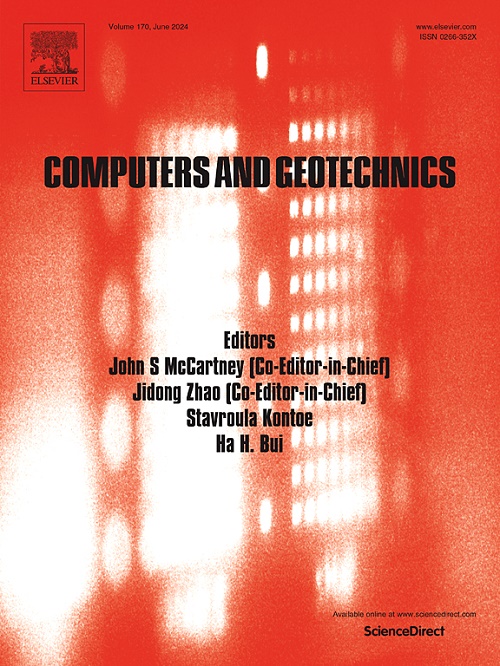基于CFD-DEM的坝滤层颗粒扩散微观模拟
IF 6.2
1区 工程技术
Q1 COMPUTER SCIENCE, INTERDISCIPLINARY APPLICATIONS
引用次数: 0
摘要
过滤层是防止土石坝内部侵蚀的重要组成部分。其设计通常取决于滤料与基土的粒径分布,二者之比(即层间系数)对控制侵蚀颗粒的堵塞和截留过程起着关键作用。为了更好地了解层间系数如何影响底土侵蚀和过滤材料的保留能力,我们使用一种新的三维耦合计算流体力学离散元方法(CFD-DEM)模拟了不同层间系数下的反过滤系统,该方法包含不规则形状的颗粒。数值结果表明:(1)层间系数越小,对基层土壤侵蚀的抑制效果越好,侵蚀过程经历了快速侵蚀、缓慢侵蚀和稳定三个阶段;(2)层间系数显著影响土壤颗粒的输运行为。层间系数大于6会削弱滤料的截留能力,造成明显的地下渗透和对基层土壤的破坏。当系数小于4时,细土颗粒在界面处堆积,形成类似“滤饼”的弱渗透层。在上述数值试验的基础上,提出了一种新的滤波层设计准则,并通过文献实验结果进行了验证。本研究对基层土壤过滤系统的微观特征和渗透机理提供了有价值的见解,为过滤系统的设计提供了实践指导。本文章由计算机程序翻译,如有差异,请以英文原文为准。
Microscopic modeling of particle suffusion in dam filter layers using CFD-DEM
The filter layer is a crucial component in preventing internal erosion in earth-rockfill dams. Its design typically replies on the particle size distribution of the filter material and base soil, with the ratio between them (i.e., interlayer coefficient) playing a critical role in controlling the blockage and interception process of eroding particles. To better understand how the interlayer coefficients affect subsoil erosion and the retention capacity of filter material, we simulate a reverse filtration system under varying interlayer coefficients using a novel 3D coupled computational fluid dynamics-discrete element method (CFD-DEM) that incorporates irregularly shaped particles. The numerical results indicate that: (1) A smaller interlayer coefficient more effectively inhibits base soil erosion, with the erosion process progressing through three stages: rapid erosion, slow erosion, and stability; (2) The interlayer coefficient significantly influences the transport behavior of soil particles. Interlayer coefficients above 6 weaken the retention capacity of the filter material, causing noticeable subsurface suffusion and damage to the base soil. In contrast, Coefficients below 4 result in the accumulation of fine soil particles at the interface, forming a weakly permeable layer resembling a “filter cake”. A new filter layer design criterion is proposed based on the numerical tests above and is validated through experimental results from the literature. This study provides valuable insights into the microscopic characteristics and suffusion mechanisms of the base soil-filter system, offering practical guidance for the design of filtration systems.
求助全文
通过发布文献求助,成功后即可免费获取论文全文。
去求助
来源期刊

Computers and Geotechnics
地学-地球科学综合
CiteScore
9.10
自引率
15.10%
发文量
438
审稿时长
45 days
期刊介绍:
The use of computers is firmly established in geotechnical engineering and continues to grow rapidly in both engineering practice and academe. The development of advanced numerical techniques and constitutive modeling, in conjunction with rapid developments in computer hardware, enables problems to be tackled that were unthinkable even a few years ago. Computers and Geotechnics provides an up-to-date reference for engineers and researchers engaged in computer aided analysis and research in geotechnical engineering. The journal is intended for an expeditious dissemination of advanced computer applications across a broad range of geotechnical topics. Contributions on advances in numerical algorithms, computer implementation of new constitutive models and probabilistic methods are especially encouraged.
 求助内容:
求助内容: 应助结果提醒方式:
应助结果提醒方式:


